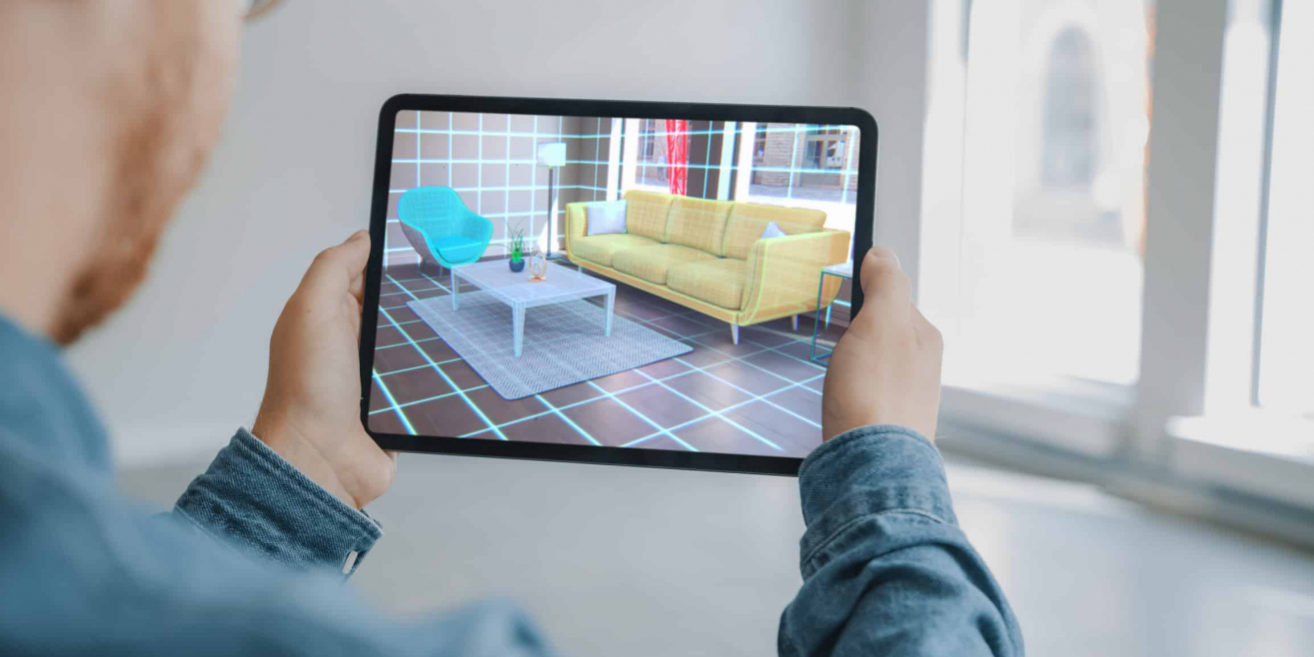Businesses are realizing the potential that augmented reality mobile apps offer to transform their industries. AR technology is raising the bar for user experience (UX) and business operations, offering new possibilities for memorable interactions and standards of business. With this in mind, let’s examine how augmented reality will continue to gain mainstream popularity over the next couple years.
The Benefits of Augmented Reality Technology
Wearables, hoverboards, smart watches and similar inventions are pointing toward the desire for innovative technology that will take us to the next level. Whether to alleviate, aid or improve, we rely on technology as the solution to our problems — business or otherwise. But what exactly can AR mobile apps offer to businesses?
Augmented reality offers companies the ability to engage customers in a way that makes a lasting impression. Businesses are perpetually looking for ways to capture and hold attention long enough to show their value. Interactions with augmented reality technology offer an experiential, emotional connection that will resonate with users.
With augmented reality, attention is captured and engaged for an extended period of time. Not only that, active participation means that customers are more likely to remember the interaction. Besides providing better service to their customers or clients, companies can also use AR apps for internal operations, fostering education and training and supporting the work of their employees.
Developing an Augmented Reality App
In addition to a highly interactive User Experience, AR apps are well positioned to become mainstream due to the frameworks and creative tools available for augmented reality development. Apple’s ARKit and Google’s ARCore provide resources, documentation and tools that developers can use to create an innovative AR experience. Based on the purpose of your mobile app, your software development partner will help you select the AR framework that is best suited for your project.
By merging or superimposing digital elements with real life, businesses can educate users, train employees and help customers imagine the impact of their products in daily life. Let’s examine how industries are currently using augmented reality applications along with possibilities for future expansion and growth.
Augmented Reality in Retail
Retailers are using AR apps, not just to sell products, but to put the idea of owning them within reach. Visualizing products with AR takes the concept of a test drive or free trial and elevates it to the next level — even from the comfort of your own home. Homeowners can use AR technology to decorate by visualizing furniture and superimposing products into their home environments. Want to see how a couch or a new paint color would look in your living room? Skip the swatches, samples and side-by-side paint streaks and enjoy an augmented reality preview.
Homes aren’t the only things that can get a makeover. Customers also use AR apps to explore clothes, makeup, haircuts and other methods of digitally altering their appearance before making the commitment in real life. How else could you try out an assortment of completely different hairstyles within seconds?
| Industry Example of AR: 7T worked with a client to develop an augmented reality fitting app, helping customers to order their correct size when shopping online. Besides offering a personalized shopping experience, the custom body scans helped to drastically reduce returns and exchanges. Check out this business application of augmented reality here. |
AR applications can influence the way we express ourselves and how we shape the world around us by allowing users to discover new possibilities while reducing the potential for failure. When you develop an enterprise AR app, you can bring your customers’ visions to life and let the products sell themselves.
Uses of Augmented Reality in Real Estate
Virtual home tours were in high demand this past year, as lockdowns from the pandemic kept prospective renters and home buyers from scheduling in-person tours — many buying houses unseen. Even in non-pandemic days, augmented reality allows realtors to digitally stage their houses and apartments and show off their listing online. This then allows them to focus their time and in-person tours on those who are truly interested in a property. Once in the door, buyers or renters can use augmented reality to add their own touch and visualize what it would be like to live in that space.
AR in real estate helps to foster a self-selecting process while meeting the desire for prospective homeowners to explore at their leisure, on their own terms. Thanks to AR real estate apps and an interactive and personalized home buying experience, increased efficiency can help realtors grow their business.
Uses of AR Technology in Arts, Education and Entertainment
AR technology is fostering creativity and education in schools, bringing concepts to life for kids. However, adults can also get in on the learning action. Museums, art galleries, parks, wildlife centers, you name it; AR maps guide visitors throughout the facilities, saving resources and allowing visitors to use their own devices as they navigate around.
With an AR app, educational or entertainment facilities can also offer a wider variety of features and information with digital content accessible through their app. Self-guided tours and interactive exhibits utilize AR tech to enrich the experience, bringing displays to life and fostering hands-on learning in a memorable way. When people actively participate in learning, they are more likely to retain the information. Other AR apps help to encourage the exploration of new subject areas and bring opportunities for learning into our daily lives.
| Industry Example: There are many examples of augmented reality available in the app store, from games to AR business apps. Perhaps one of the most common uses of AR is photo filters offered by popular social media sites like Snapchat and Instagram. Other fun favorites include Astronomy AR apps that show us the stars and constellations without the use of a telescope. |
Types of Healthcare AR Apps
Augmented reality in the healthcare field is helping healthcare professionals to explain procedures and promote general wellness in an easy to understand way. Utilizing healthcare AR apps, they can show patients tissues, organs, muscles, bones and more for a more in depth understanding of the body and how it functions. Medical students are also benefiting from healthcare AR, visually learning the different systems of the body and even practicing procedures using AR and VR technology. Besides being used for med school or in a lab setting, healthcare AR is also starting to enter the operating room, helping to guide surgeries and other procedures in real time.
| Industry Example: The HoloAnatomy app is an interactive educational software that displays 3D images of the human anatomy for students to observe and interact with, improving learning and information retention. As the medical field continues to recognize the value of AR technology for education and patient care, we’ll likely see even more advancements in this field the coming years. |
Employee Training Using Augmented Reality
Businesses continue to explore the use of AR technology for employee training and use in the field. Instructions or blueprints can be superimposed over the work site or kept within reach with the use of a wearable device. With project and instructional information always on hand, businesses can operate with a high standard of professionalism and provide top quality workmanship. Additionally, AR technology can help increase the efficiency and focus of workers by alleviating the need to look back and forth at instructions or project details.
In addition to blueprints, other businesses are utilizing AR technology on construction sites and remodeling projects, helping clients visualize how the building will look once complete. The 3D models really help bring the vision to life for clients.
| For more augmented reality mobile app inspiration, check out 5 Cool Augmented Reality Apps: Ideas to Inspire Your AR App Development Project |
AR Technology for a More Sustainable Future
If a picture is worth a thousand words, think of the impact a visual experience provided by AR technology can have. AR can be used to help us think more critically about the long term consequences of our actions, such as showing the effects of smoking, aging, impact on the environment and more. Instead of serving as an escape from reality, augmented reality technology can help us envision a better future — but it is up to us to help create it.
At 7T, we work to develop a better future for our clients, improve their processes and revolutionize their industries. If you are interested in developing an augmented reality mobile app, fill out the contact form below or reach out to the 7T team today.









